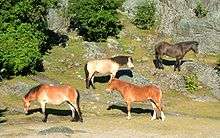Gotland pony
Gotland pony or Gotland russ is an old Swedish pony breed. Gotland ponies are claimed to descend from Tarpans that lived on the small island of Gotland that is on the South-Eastern coast of Sweden right after the last ice age. The Gotland pony is the only breed of pony native to Sweden. The Öland horse from the neighbouring island of Öland was a close relative of the Gotland, but became extinct in the early 20th century.
 | |
| Other names | Gotland russ |
|---|---|
| Country of origin | Sweden |
Characteristics

The Gotland Russ has a light and narrow build with sloping quarters and a low-set tail. Their hooves are solid and hard. This pony generally stands from 115 to 130 centimetres (11.1 to 12.3 hands; 45 to 51 in) at the withers[1] and is ideally between 123–126 centimetres (12.0–12.2 hands; 48–50 in). Three-year-old ponies must be 115–128 centimetres (11.1–12.2 hands; 45–50 in). The pony is strong and hardy and can be ridden by children and small adults.
Wildtype bay and mealy (Pangare) are very common in the breed. Common colors include bay, chestnut, black, buckskin, and palomino, but all colors except for dun, grey, and pinto, are allowed. Bay or black is usually preferred.
History
The name russ comes from a now obsolete word ross, which means a riding horse or a charger[2] and it is linked etymologically to the English word horse (in Old High German this word appeared as hros, and in English a metathesis has switched the places of the /r/ and the /o/, whereas in Swedish /hr/ became /r/, producing ross or russ.[3]
This breed of horse resembles the Hucul and Konik of Poland. Like those horses, aficionados claim the Gotland Russ descended from the Tarpan, though this is unlikely and DNA studies indicate the pattern of development was akin to most other landrace breeds, where domesticated stallions were crossed with local indigenous mares.
Once the Gotland ponies lived wild and roamed freely on the island. Nowadays a semi-feral herd is kept in the 650-acre (2.6 km2) enclosed area of Lojsta Moor where the horses live all year-round.
In the beginning of the 19th century, Gotland ponies still had free range on the island, but due to logging and increasing agricultural activities, the number of ponies had begun to dramatically decrease. Ponies were also exported to the mainland of Europe, and by 1870 as many as 200 were sold per year. They were transported as far as Great Britain and Belgium, where they were used in coal mines. Extinction of the breed was avoided when a society for the protection of the breed was founded in Sweden: "Svenska Russavelsföreningen".[4] To the society's credit, the moors and forests of Lojsta were then protected, for the ponies to live in without interference.
The first studbook was started in 1880 [5], the predecessor to an official studbook for Gotland ponies which was published in Sweden in 1943. To improve the breed, two Welsh pony stallions were also accepted in it: Reber General and Criban Daniel. The pedigree was closed in 1971 after which only registered Gotland ponies have been accepted.
Today, they are mainly bred in Sweden, Denmark, Finland, Norway and North America.
Uses
The Gotland Russ is the most common breed of pony in Sweden. It is a good all round pony and is often used by riding schools. Modern Gotlands are most popular as a riding ponies, often for children, and as harness racing ponies. They also excel at show jumping, dressage, and eventing. The Gotland is considered to be a very quick learner, and described as easy to train.
References
- "gotlandsruss". Nationalencyklopedin (in Swedish). Retrieved 14 September 2010.
- Salmenpohja, M: "Russ-yhdistys 20 vuotta" (’The 20th Anniversary of the Russ Association [in Finland], Satulassa, 1995/15.
- Webster's Seventh New Collegiate Dictionary, 1973.
- http://www.gotlandsruss.se
- http://www.gotlandsruss.se
Further reading
- Eternell Hagen, Eva (1997). Gotlandsrusset. Stabenfeldt AB. ISBN 91-7117-252-1.
External links
| Wikimedia Commons has media related to Gotland Pony. |